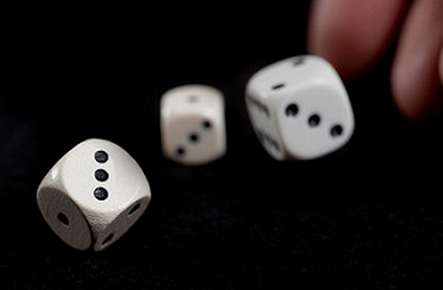Be very careful
 You are rolling a fair 6-sided dice 3 times. What is the probability that the first roll will be greater than each of the other two individually?
You are rolling a fair 6-sided dice 3 times. What is the probability that the first roll will be greater than each of the other two individually?
Image Credit: Flickr Jo Christian Oterhals .
This section requires Javascript.
You are seeing this because something didn't load right. We suggest you, (a) try
refreshing the page, (b) enabling javascript if it is disabled on your browser and,
finally, (c)
loading the
non-javascript version of this page
. We're sorry about the hassle.
5 solutions
Can someone explain what's wrong with my solution? I found probability of getting number x on first roll and then probability of getting numbers less than x and I took the sum of all those cases. Ex probability of 3 is 1/6 probability of numbers less than 3 is 1/36. I took the sum and got 20/216 then multiplied by 3 because u have three dice to get 60/216?
Log in to reply
I meant that the first player rolls a higher number than each of the other two individually. I've added clarification.
Probability= number of favourable outcomes ÷ total number of outcomes.
Total number of outcomes= 6×6×6= 216
Favourable outcomes include-
(2,1,1)
(3,1,1) (3,2,2) (3,1,2) (3,2,1)
(4,1,1) (4,2,2) (4,3,3) + 2(3C2)
(5,1,1) (5,2,2) (5,3,3) (5,4,4) + 2(4C2)
(6,1,1) (6,2,2) (6,3,3) (6,4,4) (6,5,5) + 2(5C2)
Now counting the number of favourable outcomes gives 17 + 2(3C2 + 4C2 + 5C2)
= 17 + 2(3+6+10) = 17+ 38 =55
Therefore the probability of this event is 55/216
55/216....as if 1st throw can be minimum 2 and second and third dice roll would be compulsory 1 (1/6 1/6 1/6)...similary if 1 st throw is 3 then second and third dice can be 1 or 2 (1/6 2/6 2/6)...similarly for if first throw is 4 then(1/6 3/6 3/6) as 2nd and 3 rd throw can take calue 1,2,3...so on till 1 st throw be 6... 1/6 1/6 1/6+1/6 2/6 2/6+1/6 3/6 3/6+1/6 4/6 4/6+1/6 5/6 5/6=55/216.
I've encountered this kind of problem before and I just use the property of the sequence it shows : 1 2 , 2 2 , . . . 5 2 . Thus, it has a pattern of sum of squares which is n × ( n + 1 ) × ( 2 n + 1 ) / 6 and divide it with the total space = 216 final answer would be 55/216
Let's take a look at all possible first rolls and consequent probability of getting a higher number.
If first roll is a 1,
Probability of getting a higher number in any one of the next rolls (POH) = 5/6.
Probability of getting a higher number in the next two rolls combined (POH^2) = 5/6 * 5/6 = 25/36.
If first roll is a 2,
POH = 4/6
POH^2 = 16/36.
For 3,4,5,6 we get 9/36, 2/36/, 1/36 and 0/36 as POH^2 respectively.
Adding all probabilities and taking average we get.
3 6 ∗ 6 2 5 + 1 6 + 9 + 4 + 1 + 0 = 2 1 6 5 5
If you roll x the first time there are x − 1 valid options on each of the next two rolls and for both of the next two rolls to be valid there are ( x − 1 ) 2 combinations. There are 6 3 = 2 1 6 total options hence the answer is
2 1 6 1 n = 1 ∑ 6 ( n − 1 ) 2 = 2 1 6 1 n = 0 ∑ 5 n 2 = 2 1 6 1 6 5 ( 5 + 1 ) ( 2 ( 5 ) + 1 ) = 2 1 6 5 5